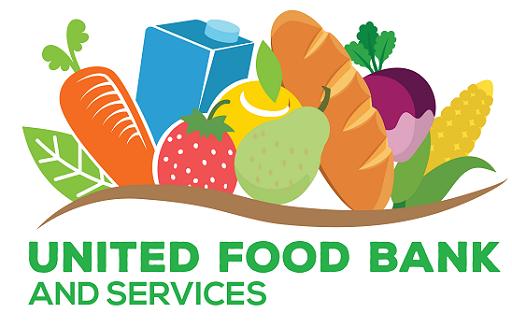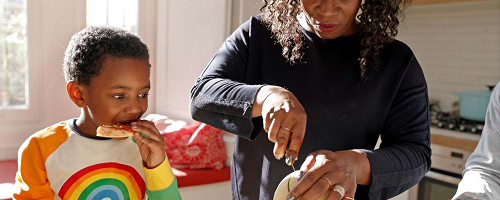United Food Bank and Services
How to Show Your Kids How to Eat for their Best Learning
As parents and caregivers, we are always looking for ways to give our children the best start in life. One of the most important ways to nurture their development is by teaching them healthy eating habits from a young age. Proper nutrition doesn’t just fuel their bodies, but it also plays a crucial role in early learning and cognitive development. The United Food Bank and Services now offers a new class called: F.E.E.D. (Food, Education, Empowerment for Development) This class is designed to teach parents the correlation between early learning and good nutrition which is generously funded by The Children’s Board of Hillsborough County.
From their first bite of solid food to enjoying family meals, the way children learn to eat has a lasting impact on their ability to concentrate, process information, and maintain good physical and mental health. Sometimes it’s difficult because kids can be picky, and it is even harder to provide healthy meals on a low-income budget. Clients tell us things like this all the time at the United Food Bank and Services in East Hillsborough County. But modeling positive eating behaviors can help set your kids up for success.
The Connection Between Nutrition and Cognitive Development
Food is the foundation of a child’s growth and health. A well-balanced diet that includes vitamins, minerals, healthy fats, protein, and carbohydrates is essential for brain development. For example:
- Omega-3 fatty acids (found in fish, seeds, and walnuts) support brain function and memory.
- Iron (found in spinach, lean meats, and beans) is crucial for oxygen flow to the brain and prevents cognitive delays.
- Zinc (present in dairy, whole grains, and nuts) contributes to memory and learning skills.
When children get the nutrients they need, their brain develops more efficiently, helping them absorb new information and retain it. This can result in improved focus, problem-solving skills, and emotional regulation, all of which contribute to early learning.
Making Mealtime a Learning Opportunity
Mealtimes aren’t just about eating – it’s an opportunity for learning. Kids learn best through reputation, engagement, and experience. Here are some ways you can turn mealtimes into educational moments:
- Introduce New Foods Regularly: Exposing your child to a variety of fruits, vegetables, and other healthy foods helps build an adventurous palate. It also teaches them that eating is about exploration, not just nutrition.
- Talk About What They’re Eating: Use mealtimes to describe colors, textures, and tastes. Engage them in simple conversations about food and how it helps their bodies grow strong and keep brains sharp. For example, “Carrots help us see better,” or “Fish helps our brain grow.”
- Encourage Independence: Allow kids to make small decisions about their meals (like choosing a vegetable for selecting a portion size”. This helps them feel a sense of ownership and responsibility, both of which are important for building self-regulation skills, which are critical for learning in general.
Modeling Healthy Eating Habits
Children often learn by watching and imitating the behavior of adults. As parents and caregivers, your eating habits set the tone for what they believe is normal and desirable. The more they see you enjoying healthy foods and demonstrating good eating habits, the more likely they are to adopt those habits themselves.
- Eat Together as a Family: Eating together not only strengthens family bonds but also provides children with a structured routine that encourages them to try new foods. Studies show that children who eat regular family meals are more likely to consume a balanced diet and are less prone to unhealthy snacks.
- Make Healthy Choices: Let your kids see you choosing nutritious options, whether it’s reaching for a piece of fruit instead of a sugary snack or preparing a balanced dinner. Your behavior sends a message that healthy eating is not a chore but a natural, enjoyably part of life.
Creating a Positive Eating Environment
Children’s attitudes toward food are heavily influenced by the environment you create at mealtimes. A stress-free, enjoyable eating atmosphere fosters positive associations with food and eating which can improve their ability to focus and learn.
- Avoid Pressure: Instead of forcing kids to finish their plate or eat a particular food, encourage them to try new things without pressuring them to eat. The goal is to help them develop a healthy relationship with food.
- Keep Meals Calm and Focused: Turn off the TV and eliminate distractions so everyone can focus on their food. This encourages mindfulness, helping children to slow down, enjoy their meals, and pay attention to their body’s hunger cues.
- Incorporate Learning Activities: Let children participate in the preparation of meals. They can wash veggies, mix ingredients, or set the table. These activities not only teach them valuable life skills but also promote motor development and understanding of where food comes from.
Using Food as a Tool for Emotional Regulation
The foods children eat can also impact their emotions and behavior, which in turn affects their learning capabilities. For instance:
- High-sugar diets can lead to energy crashes, irritability, and difficulty focusing, which are not conducive to learning.
- Balanced meals with whole grains, lean proteins, and healthy fats stabilize blood sugar levels, leading to improved mood and focus.
Encourage your child to eat meals and snacks that stabilize energy throughout the day, such as a yogurt with fruit for breakfast or a whole-grain sandwich with lean turkey for lunch. Keep sugary treats to a minimum and save them for occasional celebrations.
Incorporating Playful Learning About Food
Kids learn best through play, so why not combine food with fun learning activities. Here are a few creative ways to engage your child:
- Food Art: Use fruits, vegetables, and other ingredients to make fun, educational shapes, and designs. For example, create an animal face using slices of cucumber, berries, and cheese. This can help your child learn about different foods and encourage healthy eating.
- Food Sorting Games: Teach your child to categorize foods based on colors, textures, or food groups. For example, separate fruits and vegetables or grains and proteins. This encourages organization and helps them understand nutrition in a fun way.
Instilling Healthy Habits for Life
The eating habits of children that are formed in the early years often stick with them throughout their lives. By teaching them how to make nutritious food choices, you’re giving them the tools to develop a healthy relationship with food that will benefit them well into adulthood. Additionally, fostering a love of good food and a balanced lifestyle encourages long-term cognitive and emotional health, supporting their overall success as learners.
Teaching your children how to eat for optimal early learning is not just about providing healthy meals – it’s about creating an environment that fosters curiosity, healthy habits, and a positive relationship with food. By introducing new foods, modeling healthy behaviors, and using mealtimes as an opportunity for learning, you’ll set your child up for academic success and give them the foundation for a lifetime of well-being. Keep mealtimes enjoyable, educational, and stress-free, and watch your child’s love for food and learning grow!

